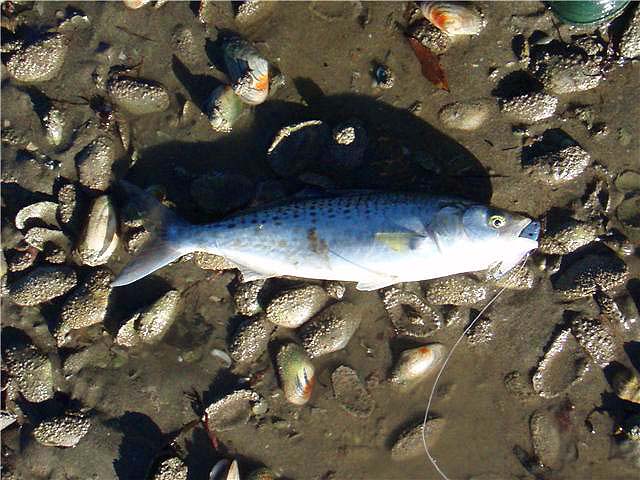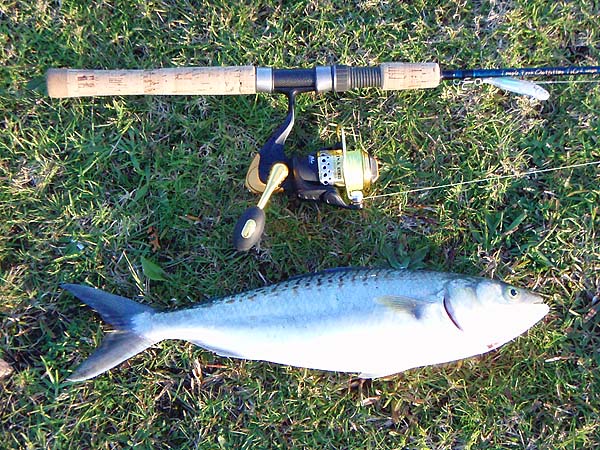 '
'Information Page.
Hell of a battle!
I really enjoy reading emails from my pal Alan in New Zealand and even though I've never been near Whangamata last week's contribution was no exception.
Email dated 08 JULY 2008
Hi Mike,
I trust that this note finds you and Lilian tanned and relaxed after the Baja sojourn. The first instalment on your website sounds intriguing and I look forward to reports on the rest of the holiday.
The weather here in NZ has been terrible for the last 2-3 weeks with persistent showers, frequent hail storms and temperatures less than 10oC the norm. Football has been postponed for two consecutive weekends and all of the grounds closed mid-week preventing training. We decided to take a couple of days off work at the start of the school holidays and head down to Whangamata to spend time with my parents, returning to Auckland today. I managed to get out on the estuary on Sunday and Monday and, despite the weather, the fishing was excellent. I hooked 11 fish on in the two sessions and landed 8.
SUNDAY 6 JULY
We got to Whangamata just before lunch on Sunday and our arrival coincided neatly with a freshly baked batch of Yorkshire tea cake being removed from the oven. This was eagerly anticipated on the way down and devoured ravenously by the team. The weather in Auckland was poor when we left with a grey drizzly day in prospect. As we neared Whangamata conditions improved markedly and by the time we sat down for lunch it was stunning. Clear blue skies, bright and sunny with a gentle breeze fanning the estuary from the SW. There was a chill in the wind but the temperature felt warmer than the 10oC forecast.
I finished lunch in record time, tackled up and was walking out onto the estuary by 1.45 pm. Low tide was at 3.30 pm so the timing was perfect. The water clarity was excellent despite Whangamata receiving a lot of rain over the past week. There were no small fish patrolling the margins and the estuary was eerily quiet. Based on the results of my last trip in June, I decided to try a soft plastic shad (Riptide Mullet) in the hope of picking up a large trevally where one of the freshwater streams feeds into the main channel. I fished the lure methodically for 40 minutes in the stretch above and around the stream with a variety of retrieves and was unable to entice a strike of any description. Even the horse mussels were strangely tight lipped!
Last month there were a lot of kahawai holding down stream of the stream inflow so I switched to a Yo-Zuri S bibless minnow and crossed the stream to see if they were still in attendance. Once again the water was peppered systematically with casts for 25 minutes but to no avail. It was not until I had travelled about 100 metres from my start point that the lure got spanked as it fluttered to the bottom. The fish was not large (around 1.5lb – see photograph) and was no match for the heavy drag setting and 8 lb braid. It tore off into the channel but could not fight the relentless side strain and was drawn between the moored boats to the shore in less than five minutes. The fish was in excellent condition and sped back into the channel upon release. I persevered on until low tide without further success. By now I had been joined by a posse of indigenous Pipi gatherers and decided to try my luck upstream of the fresh water inlet now that the tide had changed.
On the way back across the stream I noticed three shags drying their wings and having a noisy tete-a-tete about 200 metres away. In the past fishing where the shags congregate has been successful so I made a bee line for the gathering. By the time I hobbled (you may recall that Alan has recently 'done' his knee ligaments playing football) to the stretch of shore where the birds had occupied it was around 10 minutes after low tide and the incoming tide has started its inexorable march up the harbour. The first cast arched out and plopped gently mid channel. The lure fluttered downwards steadily and was met with a solid thump as it neared the bottom. This was a better fish and it tore off downstream with a vengeance. I stumbled after it and was able to turn its head with side strain before it travelled too far. The kahawai then spun on its tail and headed back upstream parallel to the shore the line hissing through the tide as it struggled to keep pace. Once again I was able to keep the fish between the moored boats and the shore by applying side. This pattern carried on for five minutes but eventually I was able to beach the fish. Unfortunately as it flapped on the water’s edge it tossed the lure so I half sprinted, half staggered down to the shore and unthinkingly kicked it up the beach with my crook knee. It was about then that I remembered where my damaged anterior cruciate was located! (Excruciating?) Luckily the pain was temporary and the 2.5 lb fish secured for lunch the next day (see photograph).
I fished on for another 10 minutes and landed two more kahawai that were mirror images of the first fish. These were both returned promptly to the water to fight another day.
MONDAY 7 JULY
The conditions overnight took a turn for the worse and the showery, squally weather returned with a vengeance the following afternoon. The temperature increased to 11oC but the rain pattered down incessantly. After the previous day’s success I was determined to get out again irrespective of the conditions and ventured out onto the mudflat around two hours before low tide. The rain intensified as I reached the estuary proper and I was thankful for the neoprene gloves, thigh waders and layers of Gore-Tex clothing. The wind was still gusting from the chilly SW but with a stronger pair of lungs than yesterday.
I attached the same lure from yesterday and targeted the point where I had been successful. The first cast was picked up by the following wind and the lure dumped mid channel. It fluttered to the bottom I gave it a short rip and the lure was absolutely monstered. Line and spray poured off the spool in a blur as the fish charged off upstream into the outgoing tide in a withering 50 metre burst. The rod was bent in a tight parabolic curve and the fish felt heavy. It soon tired of moving upstream and spun on its tail and steamed off downstream in a 100 metre burst that had the line scything through the water like a razor sharp knife through paper and me reeling in line like a dervish. I was applying as much side as I dared and somehow managed to keep the fish running parallel to the shore and inside the moored boats. This zig-zagging up and downstream parallel to the shore carried on for 10 minutes and I was struggling to make any impression. I had seen the fish twice as it turned on the surface about 30 metres below me and conservatively estimated its weight at 8 lb. It was enormous - long and surprisingly rotund. As the fish screamed past me again I felt one of the trebles pull and knew that unless I could get the fish in soon it would be able to slowly and deliberately wrench out the lure as it continued to shake its head viciously. The battle continued for another 5 minutes without either of us being able to break the stalemate. Then all of a sudden the balance seemed to shift in my favour and I was able to slowly draw the fish into the shallows. As I drew the beast closer it felt the sand on its belly, broached on top in its last desperate lunge for freedom and threw the lure. Bugger, but what an amazing battle in the pouring rain!
There was no damage to the lure so I re-cast out and was hooked up again within two casts. This kahawai sped around the shallows, took to the air and gave an excellent account of itself for 5 minutes. It was another 2.5 lb specimen and was returned unharmed. It was impossible to take photographs as it was still pelting down. I fished on up and down the estuary for another 1.5 hours and hooked a further 5 fish. Three made it to the bank and two more managed to throw the hooks after hitting the lure almost as soon as it splashed down into the water. All of the fish were between 1.5 – 2.5 lb and fought spiritedly but their efforts palled into insignificance compared to the big fish that “got away”.
The key to catching the bigger Kahawai that make their way into the estuaries at this time of the year seems to be fishing when the tide is moving. Around slack tide the fishing was very hard and unproductive but it was electric when you located a holding area and it coincided with steady tidal flow. Overcast rainy conditions also seem to have a positive effect on results. Interestingly most of the really big fish that I have landed at Whangamata have all been caught in decidedly dodgy weather during the cooler months. More research required!!
I look forward to your latest instalment. Tight lines and very best regards,
Alan Bulmer
How about that! There aren't many (?any) fish in our waters that would give you that type of action. Kahawai obviously do exactly what it says on the body shape. Must go to NZ!!!!!
If you have any comments or questions about fish, methods, tactics or 'what have you.'get in touch with me by sending an E-MAIL to - docladle@hotmail.com
Small kahawai.
 '
'Bigger one.
 '
'